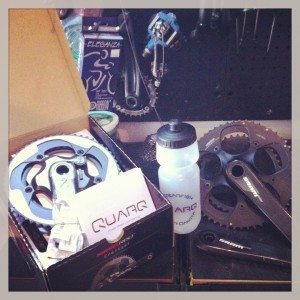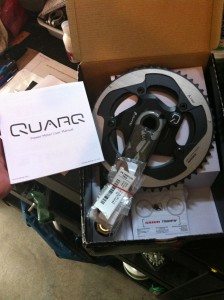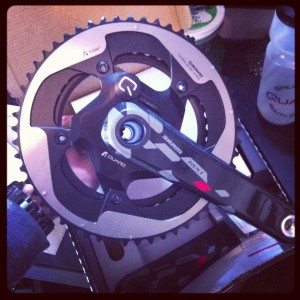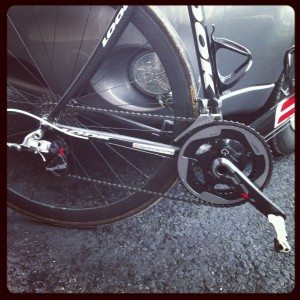 After managing to put paid to my third Cinqo power meter, Quarq went above and beyond the call of warranty service and upgraded me to a Red Exogram power meter to replace the problem child Cinqo. I detailed the warranty process in this post, so you can read about it in detail there. Suffice to say, Quarq was wonderful throughout the process and I feel confident recommending them and their power meter units to anyone.
After managing to put paid to my third Cinqo power meter, Quarq went above and beyond the call of warranty service and upgraded me to a Red Exogram power meter to replace the problem child Cinqo. I detailed the warranty process in this post, so you can read about it in detail there. Suffice to say, Quarq was wonderful throughout the process and I feel confident recommending them and their power meter units to anyone.
As for the Red Exogram model, while it may look similar, in reality it is a radical departure from the (now discontinued) Cinqo model, both in terms of the power meter spider and the SRAM crank components themselves.
After the jump we'll take a look at the Exogram unit as a whole and as a sum of its parts.
 Model Differences
Model Differences
As I had been told by Quarq techs, the Cinqo was a “Saturn” model power meter. This means that the electronics pod was attached to the strain gauge containing spider via a 12 pin connector, offering a conduit for moisture to get into the crank and ruin the unit. The Red model is based upon the new “Mercury” platform, which encloses all the electronics into a CNC machined spider. This means there are far fewer points of failure: the only real place moisture can enter the spider is through the battery cover (unless there's a physical crack or other failure in the spider.)
According to Quarq, this new design will solve all the issues that cropped up with my Cinqo units. Supposedly the Mercury platform has been out for a couple of years, being the platform of choice for Cannondale and Specialized branded Quarqs. I have to say, throughout my testing, they appear to be correct in their assertions.
Crank Technology
Since SRAM purchased Quarq, it's only fair to assume that SRAM would be using their top of the line Red cranks on this model. The arms are hollow-formed carbon arms similar to the new Exogram crankset, but with a couple of important differences. There's no moulded spider on these cranks, nor does the Quarq unit use a true “hidden bolt” design. Obviously there can't be a moulded spider, otherwise the power meter unit wouldn't be able to fit onto the crank arms. In terms of the lack of “hidden bolt”, you may be confused and saying “but there IS a hidden bolt.” Well, you're partially correct. The chainrings do not bolt into the back of the actual crank arm itself, again because of the separate Quarq spider. If the chainrings bolted into the crank arm itself, power measurement would be compromised, if not completely impossible. The crank arms are rotated around 30 degrees to take advantage of the new timing of the Red chainrings.
 Speaking of chainrings, yes, the Quarq model does utilize the X-GlideR chainrings that first appeared in the revamped Red group. Designed and optimized for the new Yaw derailleur system, they are thicker, stiffer rings when compared to the older Red rings. The ramps and pins are all adapted from the excellent XX mountain bike group, and the CNC machining allows for specific tooth shaping in order to assist with shifting precision. The big downside of these rings, however is the significant weight penalty: about 150 grams for the large chainring, which is not insignificant by any means.
Speaking of chainrings, yes, the Quarq model does utilize the X-GlideR chainrings that first appeared in the revamped Red group. Designed and optimized for the new Yaw derailleur system, they are thicker, stiffer rings when compared to the older Red rings. The ramps and pins are all adapted from the excellent XX mountain bike group, and the CNC machining allows for specific tooth shaping in order to assist with shifting precision. The big downside of these rings, however is the significant weight penalty: about 150 grams for the large chainring, which is not insignificant by any means.
Quarq Technology
Not only is the crank new, but the Mercury platform is “new” to the lineup as well. As mentioned previously, it has been utilized in the Cannondale and Specialized branded Quarqs for a couple years now, so it has been well tested. Delving deeper into the technical specs, we'll find that the Quarq unit features an external ANT+ ID etching, an easy to source CR2032 battery, an LED to indicate power on and set zero, Power Balance left/right power measurement and OmniCal calibration free chainring changes.
Of these, the biggest of note are OmniCal and Power Balance. OmniCal, of course, is a technology that allows users to swap chainrings without having to do a static recalibration using the Qalvin app (iPhone or Android compatible with an ANT+ key) or without having to send the unit back to Quarq. This is one of the most welcome changes to the Quarq unit, since it allows swapping of larger or smaller chainrings, or even stiffer chainrings such as time trial rings from SRAM.
Power Balance is the unit's ability to measure power on the right and left downstroke independently. In actuality, it's a software function that teases out the power from the right downstroke and left downstroke and displays it on screen. What is the value of something like this? Well, it may be valuable to determine muscular deficiencies or strength differences, possibly as related to fit issues. Really, the coaching community hasn't embraced left/right power yet, and it will be interesting to see where it goes.
All the features in the world don't make much difference when your power meter dies on you, but this model has been flawless thus far. Out of the box, I had to install a new, thicker cadence magnet (included) to fit with the redesigned spider. Removing the bottom bracket and installing the magnet was a simple affair, taking only a few minutes to accomplish.
The crank slid right into the bottom bracket with no issue and the non-drive crank arm bolted on with no problem. Installing pedals is a no brainer. Then it was time to spin the cranks and pair up.
The LED blinked, the Garmin cheeped, and the “Power Meter Found” box popped up on the screen, indicating a successful pairing. I threw my leg over the top tube and off I went on my maiden voyage with the Exogram. 18 miles later (hey, it was late in the day) and through a few sprinkles of rain, the Red Quarq fared perfectly. There were no dropouts in the power transmission from the unit like I had experienced with the Cinqo model, nor were there any blips in the left/right reporting. Since that initial ride, I've had absolutely no problems with the Quarq: pairing, riding and functions has been just peachy.
The only thing I'm less pleased about is the weight of the chainrings, but that's a minor concern when the performance is factored in.
If you want to pick one up, [easyazon_link identifier=”B007Q4OK7C” locale=”US” nw=”y” tag=”taicoaandthed-20″]here's where you can do that[/easyazon_link].
Update 5/20/15: After about 8,000 miles on this unit, 2 seasons of racing, torrential rain, and all manner of abuse, this Quarq is still going very strong. I couldn't be more pleased with both the service and the quality of the power meter from SRAM/Quarq.
